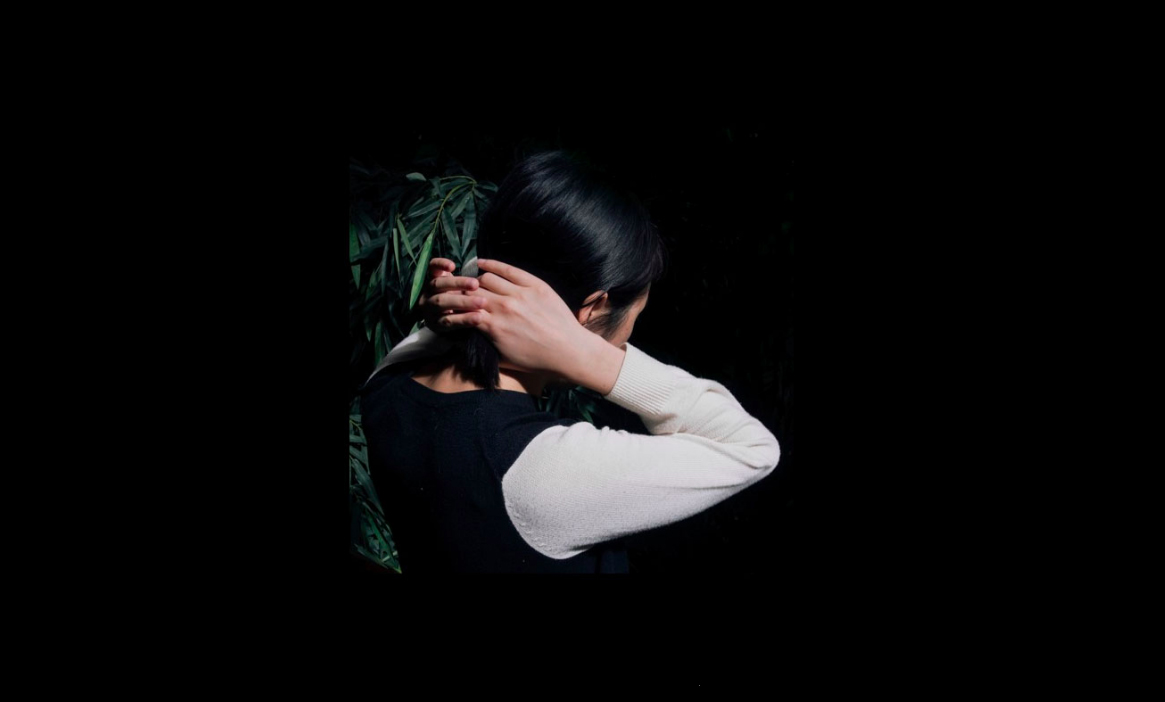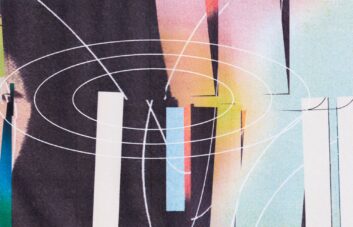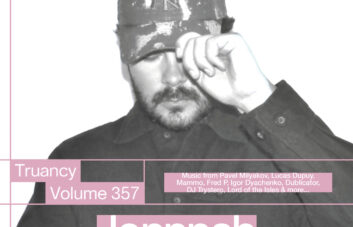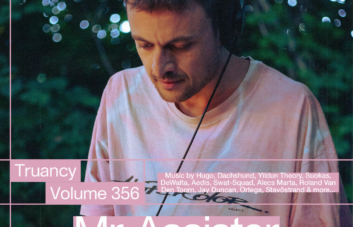Truancy Volume 149 comes courtesy of Sydney-based chunyin, ahead of her forthcoming ‘Code Switch’ EP on Off Out. Many will know chunyin from her pop project Rainbow Chan, a local favourite who has been working in the scene for many years. chunyin, however, is the grit under Rainbow Chan’s poppy sheen, the foggy night to its sparkling day. Focusing wholly on the dance floor, chunyin pulls and stretches wonky techno into something always compelling and affecting. Playful earlier tracks, like Softcall 101 (below) and Ori, step in straight from the uncanny valley, while the forthcoming EP takes on a punishing percussive edge where fragments of Chinese cinema and language drift over jacking kicks and swarming snares. While in a world of its own, the project coincides with a slew of other amazing Sydney-based artists making dark, drum-heavy music like Cassius Select, Hannah Lockwood and Copy Envy, who feature in the mix.
The project drifts between DJing and the live setting, where she uses “cheap plastic shit” to create jagged and brutal soundscapes. For TV 149 we’re treated to an exclusive mix, an excursion through murky techno where she slings Elysia Crampton next to Paula Temple. We also caught up with Rainbow in a sunny park for an extended interview, which can be found below.
You’ve spent a bit of time at universities, as a student and as a teacher. How have your experiences in music academia informed your music making? In not a very glamorous way. I took this introduction to digital techniques course, which was really basic but it was the first point that I learnt how to make something on the computer, like translate what I had imagined in my head through this very practical, easy interface. Also the more sociological and ethnomusicological elements were really fascinating for me. I started to think about music outside of pure aesthetics. I wanted to see how music is informed by culture and language and interactions and what-have-you. I felt like academia was a way to open up that aspect of my thinking.
So with the earlier Rainbow Chan work, you were mainly working with acoustic instruments rather than a computer? Yeah, I was using acoustic instruments for years as I started songwriting at a very young age. But as I got a bit older, the things that were the most interesting to me were the composers who used instruments in an unconventional way. So with the sax, I really liked pieces that used multi-phonics or key slaps and tried to transform the instrument into a non-organic sounding instrument, making it more industrial or a bit electronic. So that was always at the back of my mind, I just didn’t have the tools to translate it. When I started making things on the computer I think my sense of rhythm really improved. I started to understand, ‘Oh my god, rhythm can do so much and create energy and mood with just two drum sounds depending on the syncopations, depending on what tensions you create.’ I was never very good at jamming. I remember when I was in the school band I would suck at the solos because I couldn’t understand how the sax would fit over the drum beat. I just had no grounding, but as soon as I had my own time, spending 5 hours listening to one loop on repeat, I started to actually feel the music in this more bodily way. I didn’t think about it in terms of notation, I was actually feeling it – now, when I’m teaching rhythm to kids, I get them to bop along and I dance along too and it sticks with them. I think now I really understand that there’s an inextricable link between dance and rhythm – it sounds so obvious but once it hit me, it was very liberating.
I’m interested in the differences between Rainbow Chan and chunyin and it’s cool hearing that there is this kind of split between classical training and computer process, or between melody and rhythm and also the different technologies behind each monniker. Did working with the computer in that rhythmic mode lead to developing your style as chunyin? Yeah, there were a few different reasons. Rainbow Chan is so based around my stories, my anecdotes – my face even, in the way I present the work. It’s very personal. As a result of that it’s been received as this very gendered thing. I really wanted to make a project that was a bit more anonymous where my voice isn’t featured as much, or is obscured, and working more with samples and having it mainly instrumental. With Rainbow Chan, as a pop project, there are so many layers of refining this, refining that, going through a mix with this person, going through a master with that person, making a video clip, so many layers of mediation. I wanted to write some tracks that I could chuck up on soundcloud without any thoughts, as a way to free myself from those industry standards or expectations. So I was writing really quickly as I was travelling, doing everything in one sitting in spaces like hotel rooms, shopping malls or cafes. I was mainly in Hong Kong and Tokyo at the time, and I guess I was influenced by the frenetic energy of such a high-density space. There are so many people walking around but you also get that anonymous feeling of being swept up in the flow of people and I liked that energy. So that was translated in those first pieces working under chunyin, but I want this project to evolve around rhythm and different kinds of landscapes, evocative in an abstracted way – not so much about me as a person or a personality.
The press release mentions that you were working with some samples from Hong Kong new wave cinema, how did that factor in? There are Chinese samples in some of the tracks and some of the titles are Chinese as well. As the songs aren’t lyric-based, I feel the project was a good chance to explore Chinese culture and draw on different things that interest me in the Chinese language. For example, the track called ‘Shi’ is based on this poem in Chinese that uses only the sound ‘shi’ but in 92 different ways where each word means something different. So the poem is just like ‘shi, shi, shi, shi…’ but it translates to something like ‘the poet eating a lion in a stone den’, so I was curious about looking at different ways that language works – and using that as an idea in music, maybe your theme gets varied in a bunch of ways in a song. Yeah, I suppose that’s also really similar conceptually in dance music, with focus on repetition, sonic mutability etc. Yes, like repetition but where the second or third repeat means something completely different because of the way it’s placed, or because there’s a sweep behind it now and it’s leading towards a different sensation. Using repetition as a strategic way to create some sort of flow or tension.
I was listening to the EP this morning and it reminded me a lot of industrial and early Detroit electro and techno – was that a reference point for the EP? I feel like I still have a lot to learn, like the first track on the EP, Fei, was my first attempt to write a dance track and I think that’s what attracted Steve Braiden. After I made that track I started to listen to more techno and got really into Drexciya and Gerald Donald’s other project Glass Domain, which is amazing. I really like Paula Temple and there are a bunch of other female producers locally who I find very inspiring, like Hannah Lockwood and Lucy Cliché. So I wouldn’t say I’m particularly well versed in dance music, and I try not to think about in terms of following a particular genre or sound because I know someone else will do it better – I’m also not from that social scene in Detroit or wherever and I can’t replicate that. So I just try to listen to a wide variety of stuff and come up with something that’s fused together – I wouldn’t be comfortable attaching myself to a particular genre. I also wanted to ask about 4/4 or 4 to the floor, relating back to danceability and body music, like 4/4 is the beat of your heart and cute stuff like that. The EP and other chunyin tracks are very much on that grid. Yeah, I feel like with these tracks, they needed a 4/4 because everything else is kind of flying all over the place, so it needed that to ground it. I did send a few tracks to Steve that weren’t in 4/4 and he was like, ‘Whoa, this is some crazy out-there shit, I’m not sure if I can put this out!’ (laughs) I did want this record to be a dance record and for the first time I was thinking about my music serving a function. When you’re on the dance floor, there is something very satisfying about that 4/4 rhythm. Having that constant beat allows a lot of tension on top of that, like playing against that beat. And that’s what I’ve been trying to look at, to syncopate against the beat as a focus.
One thing I wanted to talk about that plays into this is the idea of plasticity, maybe not so much the EP but a lot of the earlier tracks you had on soundcloud, like ‘Softcall 101’, there’s a super plasticky synth in it. I know you’re a big fan of YMO as well who were into the plastic life and it also ties back to like Shanzai culture and your art piece at Justin Shoulder’s exhibition at First Draft recently, about fakeness and simulation and so on. Yeah, I feel like my interest in Shanzai culture and counterfeit goods is an ongoing, evolving, body of work that is beyond this chunyin project. It’s something that I’ll be exploring for the next 5 to 10 years of my life. The thing I did for First Draft was just the tip of the iceberg. I’m learning more and more about the cultural, political and economic consequences of this phenomenon. And it’s such a big picture, it’s like this giant global ecosystem that’s really difficult to unpack. But yeah, plastic and the idea of fakeness and the uncanny were subconsciously a driving force behind chunyin. Just not being fixated on the idea of presenting myself as a very genuine, neat grand narrative. I wanted to create almost like an uncanny version of myself. And using those MIDI sounds, like YMO, who were kind of cheeky. They often self-Orientalised and were very self-aware of their image. And with chunyin I wanted it to be flexible and fluid, so I could play in art spaces and sound-based events, to have no borders around it and have it as like this melted plastic thing that can seep into different spaces.
I remember you were using some weird piece of gear last time I saw you play. It was like a little pen or something. That’s a stylophone – when I was doing those initial sets I wanted the set up to be as compact and simple as possible. I didn’t want to bring giant keyboards and stuff like that. So many sounds are made on the computer so I didn’t want to have an artifice of being like ‘here’s my big expensive gear.’ I just wanted to find cheap plastic shit that I could make into an interesting track. I’m not a believer in gear fetishism. So the stylophone was kind of perfect, it has some really great functions – you can shift between three octaves and it has this stylus you can run up and down and it has this very cheap sound. It has a portamento dial at the back, so even though the keys are fixed into the twelve tones, like on a piano, you can make it pitch bend in crazy ways. It’s just such a shitty piece of gear but it’s so versatile. And in combination with all the other shit gear that I have, you can create heaps of really cool stuff. That’s really cool as well, the parallel between the conceptual aspect of plasticity and then using really shit plastic gear, and also the idea of danceability and how movement is also kind of built into the machine with the stylus. So it’s definitely a McLuhan vibe. Yeah, it’s almost like that piece of gear is a metaphor for what I’m doing. There’s the keys on the top but it’s almost like they’re fake keys, it’s not a button or a lever. They’ve just drawn some lines on this piece of metal, but the dial at the back is the thing that determines what key that grid is in. So I feel like it’s actually quite metaphorical for what I’m doing, like there’s this grid on top but everything underneath it is fluid and flying around a bit. It’s like a grid but it’s always contingent on something else – I feel like that’s kinda what I’m doing with the music. Does that sound really wanky? (laughs) No! Not at all, that’s really lovely. So were most of the tracks from the EP made on a DAW? Yeah, I was using Cubase and Garageband actually. Cool! Rock on! The Garageband interface is actually so easy – the old version anyway, the new version is fucked cos they want you to pay and upgrade. I tried to incorporate a bit of hardware too, like running things through my sampler and then back into the computer. But it is pretty much computer music. And I guess that’s why it has this certain depersonalized aesthetic to it. It’s almost like a screen or something, but you can hear that there’s a body dancing behind a screen.
It’s intense how, in the Australian cultural condition, there’s a huge desire for the other, especially musically, so there’s heaps of people who are like ‘oh I love UKG, I’m going to make that’. So we’re always observing/surveying other cultures. Yeah, I feel like this is kind of a political thing as well. But perhaps it is a symptom of being a post-colonial society and, of course, the original music from this land is Aboriginal music. So maybe we’re looking outside because we have a vexed and troubled relationship with our nation’s past and ongoing racism. But for me, personally, I felt another sort of pressure as a first-generation immigrant. I was born in Hong Kong and then grew up in a predominantly white society here – I had my own anxieties to deal with, and that’s the source of inspiration for me. So for me I’m more preoccupied with trying to deal with the tensions of being in a diasporic Chinese community and not really knowing where my home is and feeling isolated and alienated from Chinese culture and having to reconnect with it as I got older. Because growing up, I felt like my Chinese heritage was not something I wanted to talk about with my white friends. Going through school I was always seen as the other, but because I came here when I was six, I also kinda assimilated to Australian culture. I would go to Chinese school on Saturdays and I would hide that from my friends. I would go to temples and hide that from my friends. I wouldn’t tell them about the food I ate at home. So that is maybe reflected in the EP, it being called ‘Code Switch’, having Chinese influences while having it techno-based, which I guess is mainly a Western aesthetic. So it’s an exploration of the cultural merging of my influences.
So give me the goss on the EP, how did it all come about? The EP came about when my demo was discovered by Steve Braiden, who is based in London and Berlin. He was quite taken by this very mish-mash demo I sent, because it was such a bugged out version of dance music, so he couldn’t quite wrap his head around what he was listening to. (laughs) After he got in touch I was super excited, I didn’t think about it as a project that would expand beyond just studies. I feel like the tracks on the record that aren’t super refined. Steve really liked the rawness, I made some much more polished, refined tracks and he was like, ‘Er… no, let’s go with the earlier ones where you hadn’t been listening to too much Drexciya yet.’ (laughs) So I guess there’s a rudimentary rawness to all the tracks, and they’re quite jacking and brutal which was quite cathartic for me because I was sick of being soft, or of people perceiving me as soft. People are often surprised when I play as chunyin, which is nice. They really don’t expect my music to sound like chunyin. People are like, ‘Whoa, it was so intense and so abrasive.’ I question whether that’s because of superficial things like the way I look, because I’m a woman, and I’m small, and Chinese. But it’s still refreshing to have people nicely shocked by it. Do you have a release date yet? It should come out on 12” in mid-July or August. I think the packaging is going to be quite beautiful because we wanted the material iteration of the record to reflect the sound – I illustrated the cover and then that was screen-printed again – like what I said before about the body dancing behind a screen? So there’s signal degradation, a gritty version of a sheen thing. Steve said something quite nice about the songs sounding like they’re bursting at the seams but there’s a reigning in at the last minute. I feel like maybe that’s the thematic and aesthetic thread of all this chunyin stuff.
Tracklist:
Ahnnu – Anneal
Corin – Ultra
Neinzer – Cahchou
Randomer – Dem Thing
Lucy Cliche – Drain
Cop Envy – Felix
Thomas William + Kane Ikin – Yeepers
Hannah Lockwood – Grip
Glass Domain – Shatter Prone
Nicky Crane – 1/5 Turk
Paula Temple – Deathvox
Elysia Crampton – Petrichrist
Dro Carey – Expo Theme
Air Max ’97 – Fruit Crush
Enderie – Ataque As Hordas Do Poder
Haruomi Hosono with Friends Of Earth – Alternative 3
Laurel Halo – Melt
Chunyin: Facebook, Soundcloud,




